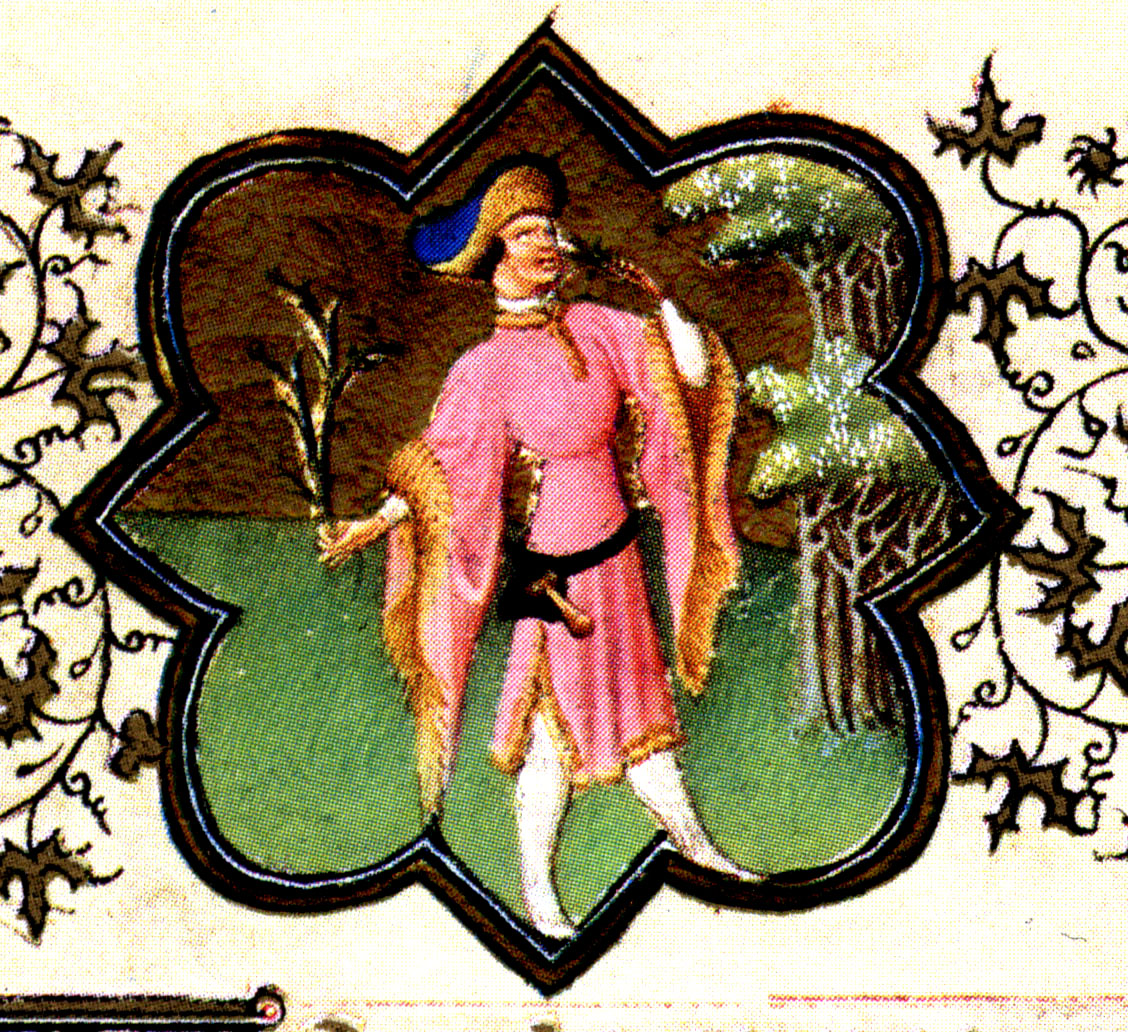
Return to main page
Because I have an edition that reproduces all the important miniatures, this manuscript is a good example of the types of scenes in which shepherds appear and the types of pouches seen in an early 15th century book of hours. The Belles Heures are first mentioned in an inventory of ca. 1408 and were created by the famous Limbourg brothers who also created the Tres Riches Heures.
Of the 157 pages illustrated in this book, pouches of some type appear in ten of them, of which four are associated with shepherds.
While calendar scenes are one place that shepherds appear, in this case only non-shepherds occur amount the pouch-wearers in this context. In April, we see a nobly-dressed man wearing a kidney-shaped belt-pouch with a dagger thrust through it. This style of pouch tends to be associated with upper class or military individuals, although this isn't a firm rule.
click here or on picture for larger version
November illustrations commonly include a swineherd knocking down acorns to help fatten his pigs. As discussed on the Non-Shepherds page, swineherds are the only other type of figure that appear with Shepherds Purses with any kind of regularity. The pouch seen here falls within the Shepherds Purse range, although it's definitely a bit toward the semi-circular end of the scale.
click on either image for a larger version
Two scenes show figures who are clearly intended to be beggars, in the context of portraying some part of a saint's life. The first shows St. Martin of Tours, in his most typical genre scene where he is sharing his cloak with a beggar. A second beggar in the scene wears an unshaped cloth carrier over his shoulder that appears to be a length of cloth tied at the ends (although the knot is not visible).
click on either picture for a larger version
The same style is seen, but with the knot visible, in a scene of St. Jermomes funeral.
click on either picture for a larger version
St. James the Greater -- being associated with one of the most important pilgrimage sites of the mediveal period -- carries as one of his attributes the style of shoulder bag associated with pilgrims, two of which kneel before him. This style is definted as a deep, usually roughly rectangular bag with a flap, worn on a shoulder strap. In addition to people identifiable as religious pilgrims, it is seen on travelers of all types, as in this figure from a scene of St. Catherine's body being carried to Mt. Sinai (although the traveller is probably intended to be a pilgrim as well).
click on image for larger and more complete version
The Belles Heures include all the typical shepherd genre scenes associated with the Nativity: both an annunciation and adoration specificially focused on the shepherds, shepherds as background in the adoration of the Magi scene, and an annunciation to the shepherds as background to a Nativity scene. In all cases, there are Shepherds Purses, generally of the crescent shape, although (like the one worn by the swienherd above) somewhat on the rounded end of the scale, rather than the more typical "banana" shape. Only in the annunciation scene is netting visible, although most of the other pouches are small and indistinct in the paintings.
click on any of the images for a larger version
click on images for larger versions
click on images for larger version
(this scene is also appears separately from another source)
click on picture (left only) for larger version
Meiss, Millard & Elizabeth H. Beatson. 1974. The Belles Heures of Jean, Duke of Berry. George Braziller, New York.